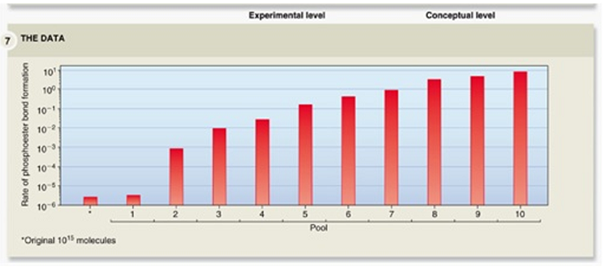Bartel and Szostak hypothesized that among a large pool of RNA molecules, some of them may contain the enzymatic ability to catalyze a covalent bond between nucleotides; these can be selected for in the laboratory. The chart below shows the results from their experiment. The x-axis shows the original pool and 10 pools that were derived from their tagging of RNA with specific enzymatic functions; the y-axis shows the rate of phosphoester (covalent) bond formation. Was their hypothesis supported by this experiment and why?

A. Yes, because pools 1 to 10 show a continual increase in covalent bond formation.
B. Yes, because the original pool shows some covalent bonds were formed.
C. No, because there is only a slight increase from the original pool to the first experimental pool.
D. No, because chemical selection would only increase the rate of covalent bond formation in the first few pools.
A. Yes, because pools 1 to 10 show a continual increase in covalent bond formation.
You might also like to view...
A cell that allows the complete replication cycle of a virus to take place is said to be a
A) permissive host. B) viral cell. C) dead cell. D) lytic cell.
The arrangement of organisms into groups is best described as ________.
A. taxonomy B. systematics C. classification D. identification
Why are human testes in an external sac rather than in the abdominal cavity?
What will be an ideal response?
Which of the following structures houses the corpus luteum?
a) ovary b) uterus c) vagina d) fallopian tube e) follicle